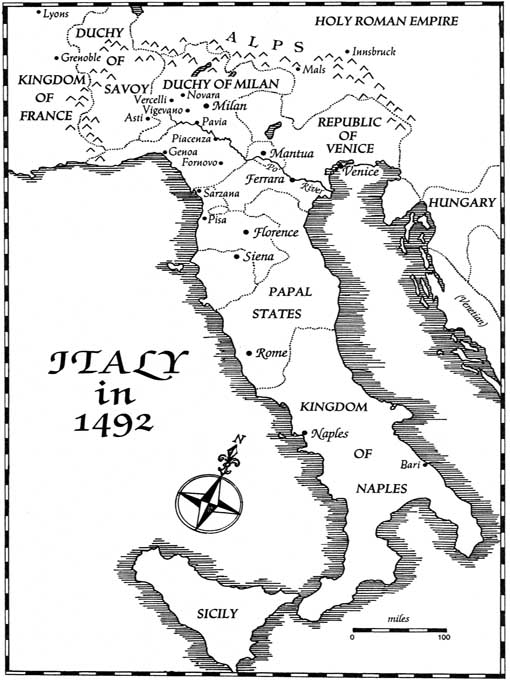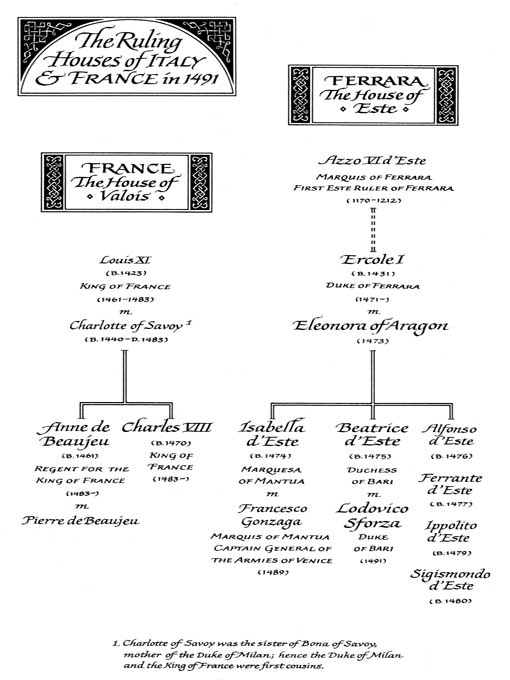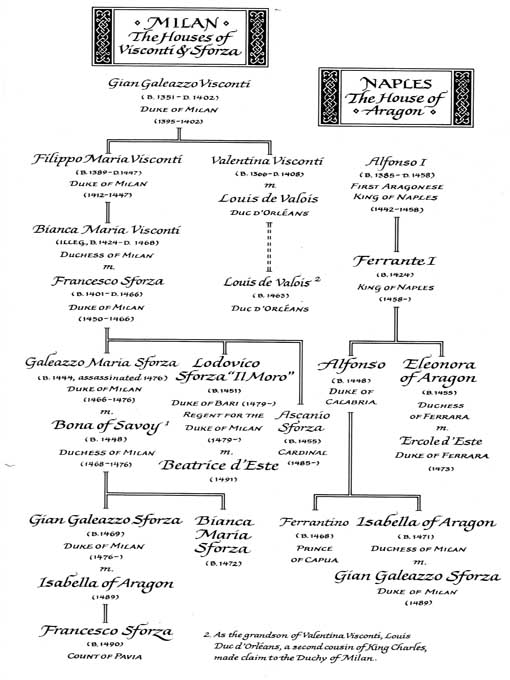Duchess of Milan


By
MICHAEL ENNIS
A Novel of the Renaissance
Copyright © Michael Ennis, 1992 All rights reserved
ISBN 0-670-83783-0
TO ELLEN AND ARIELLE
All histories are fiction. Poets were the first historians, and until relatively recent times the job was left to professional apologists, liars, and storytellers. Today's practitioners simply apply modern academic prejudices to this timeless legacy of slander, cover-ups, and geopolitical public relations. With that caution in mind,
Duchess of Milan
is a work of fiction that claims to be unusually faithful to history. The characters and events in this novel, all of whom actually lived and all of which actually took place, have been recreated as accurately as possible from letters, paintings, archives, and on-site research. The resulting drama represents a novelist's answers to questions that have kept historians guessing--and writing their own fictions--for five hundred years.
The last decade of the fifteenth century was one of the most fateful junctures in the history of the world--but not because a Genoese sea captain named Cristoforo Colombo made landfall on a few Caribbean islands in 1492. Mariners bumping into uncharted islands, whether off the Atlantic coast of Africa or slightly farther to the west, were rather ordinary news events for late-fifteenth-century cosmopolites. To the people who actually lived at the time of the discovery of the Americas it was Renaissance Italy, in the full flush of its commercial might and cultural splendor, that represented the most astonishing new world. And it was in Italy in the 1490s that history would be irrevocably fractured and realigned, set in a pattern that has determined the fate of nations, in the new world as well as the old, far into our own century.
At the epicenter of this historic upheaval was the relationship between two young women: Isabella of Aragon, the twenty-year-old wife of Gian Galeazzo Sforza, the Duke of Milan; and Beatrice d'Este, the teenage bride of Lodovico Sforza, known as “Il Moro,” Duke of Bari, regent for the Duke of Milan, and the most important man of a momentous time. But during that crucial decade, no man shook the earth quite like the passions of Beatrice and Isabella. Before their hearts were spent, they had changed the world forever.

Principal Characters
ALFONSO OF ARAGON
(b.1448), Duke of Calabria: Father of Isabella of Aragon; son of Ferrante and heir to the Kingdom of Naples.
BEATRICE D'ESTE
(b.1475), Duchess of Bari: Wife of Lodovico Sforza, “Il Moro”; first cousin of Isabella of Aragon.
BONA OF SAVOY
(b.1448), Duchess Mother of Milan: Mother of Gian Galeazzo Sforza, the Duke of Milan; aunt to King Charles VIII of France.
CECILIA GALLERANI
(b.1465), Il Moro's mistress.
CHARLES VIII
(b.1470), King of France: Nephew of Bona of Savoy; first cousin of the Duke of Milan.
ELEONORA D'ESTE
(b.1455), Duchess of Ferrara: Beatrice's mother; daughter of Ferrante of Aragon.
ERCOLE D'ESTE
(b.1431), Duke of Ferrara: Beatrice's father.
FERRANTE OF ARAGON
(b.1424), King of Naples: Beatrice's maternal grandfather; Isabella of Aragon's paternal grandfather.
GALEAZZO DI SANSEVERINO,
referred to as
GALEAZZ
(b.1461): Captain General of the Armies of Milan.
GIAN GALEAZZO SFORZA,
referred to as
GIAN
or
GIAN GALEAZZO
(b.1469), Duke of Milan: Husband of Isabella of Aragon; nephew of Il Moro.
ISABELLA OF ARAGON
(b.1471), Duchess of Milan: First cousin of Beatrice; daughter of Alfonso.
ISABELLA D'ESTE,
referred to as
THE MARQUESA
or
BEL
(b.1474), Marquesa of Mantua: Beatrice's sister; wife of Francesco Gonzaga, Captain General of the Armies of Venice.
LODOVICO SFORZA,
known as
IL MORO
(b.1451), Duke of Bari and regent for the Duke of Milan: Beatrice's husband; uncle to Gian Galeazzo Sforza, the Duke of Milan.
A genealogical chart showing the ruling houses of Italy and France in 1491 appears below.


Supporting Characters
Ambrogio da Rosate:
Chief physician and astrologer at the Court of Milan.
Anne de Beaujeu:
Sister of King Charles VIII, and his regent;
de facto
ruler of France.
Antonello di Sanseverino:
Exiled Prince of Salerno; uncle of Galeazzo di Sanseverino; adviser to Charles VIII.
Bernard Stuart d'Aubigny:
Adviser to King Charles VIII; head of French embassy to Milan in 1491.
Bernardino da Corte:
Assistant castellan of Porta Giovia and Il Moro's chief of security.
Bianca Sforza
(b.1480): Illegitimate daughter of Il Moro.
Bianca Maria
Sforza (b.1473): Sister of the Duke of Milan; daughter of Bona of Savoy; later, wife of Emperor Maximilian.
Count Carlo Belgioioso:
Milanese ambassador to France.
Francesco Gonzaga:
Marquis of Mantua; Captain General of the Armies of Venice; husband of Isabella d'Este.
Francesco Sforza
(b.1490): Count of Pavia and heir to the Duchy of Milan. Son of Isabella of Aragon and Gian Galeazzo Sforza.
Giacomo Trotti:
Ferrarese ambassador to Milan.
Girolamo da Tuttavilla:
Senior diplomat at the Court of Milan.
Guillaume de Briconnet:
Bishop of St. Malo, later Cardinal. Principal adviser to King Charles VIII.
Leonardo da Vinci:
Engineer and painter at the Court of Milan; employed by Il Moro beginning 1482.
Louis de Valois,
referred to as
Louis Duc d'Orleans:
Duke of Orleans; cousin of Charles VIII and First Prince of the Blood. Claimant to the Duchy of Milan by virtue of descent from Valentina Visconti.
Maximilian:
Archduke of Austria; later, Holy Roman Emperor (referred to as
German Emperor).
Polissena Romei:
Matron of honor to Beatrice d'Este.
Vincenzo Calmeta:
Beatrice's secretary; poet.
Deceased
Bianca Maria Sforza,
nee Visconti (b.1424, d.1468): Il Moro's mother; wife of Francesco Sforza; illegitimate daughter of Filippo Maria Visconti (see below).
Filippo Maria Visconti
(b.1389, d.1447): Last Duke of Milan representing the House of Visconti, which had ruled in Milan since 1277.
Francesco Sforza
(b.1401, d.1466): Il Moro's father; first Sforza Duke of Milan (1450-1466). A famed
condottiere
--mercenary commander--employed by the Visconti, he was wedded to Filippo Maria Visconti's illegitimate daughter Bianca Maria, and claimed the title of Duke of Milan when Filippo Maria died without a legitimate heir.
Galeazzo Maria Sforza
(b.1444, assassinated 1476): Eldest son of Francesco Sforza; Duke of Milan from 1466 until his death. Il Moro's brother; husband of Bona of Savoy and father of Gian Galeazzo Sforza, the Duke of Milan.
Milan, December 1490
“Massage the soft parts.” The voice of Messer Ambrogio da Rosate, chief physician and astrologer at the Court of Milan, soughed mysteriously from his dotage-slackened lips.
The Duchess of Milan could not hear this whispered prescription, even though she was seated in the birthing chair directly beneath Messer Ambrogio's watery gaze. But she observed the physician motioning silently with the tips of his fingers and the midwife reaching for her like a taloned Harpy materializing from the black haze of her pain and fear. In that moment the Duchess detected the first glimmer of the light, and she told herself that she must fly toward it.
“Get away from me,
puttana!
If you touch me there again I will kick you in yours!” the Duchess heard herself scream, though only distantly. She believed that it was not her muffled voice but the light, an abstract golden fog in which she could float, that somehow had made the midwife recoil. The Duchess pulled back the fine woolen chemise draped over her upper thighs. She placed her fingers to her distended, searingly numb “soft parts” and felt her baby's smooth wet skull. “He's coming!
Al nome d'Iddio Gesii,
he's coming!” She arched her back, and the push was so powerful that she imagined the light sucking her insides out. She groaned as if possessed, then shrieked: “Get your back against the chair, you dribbling bitch!”
The midwife, joined by one of the Duchess's ladies-in-waiting, scurried to brace the heavy oak birthing chair. Messer Ambrogio motioned for his assistant to lift the Duchess's chemise, and he crouched to peer between her legs. His wiry eyebrows arched with alarm, and he moved swiftly to the door, trailing his long velvet cape. He stepped into the hallway and confronted the chamberlain posted by the door. “The witnesses.” Messer Ambrogio gasped for a reinforcing breath. “Bring the witnesses in again. I am certain that this time the Duchess will give birth.”
Within a few minutes a half-dozen men, all of them ranking clerics in heavy damask cassocks or officers of state in embroidered silk tunics and bright woolen hose, stood peering at the bloody head emerging from beneath the hem of the Duchess's chemise. Messer Ambrogio motioned for his assistant to pull up the hem again so that the witnesses could irrefutably testify to the infant's authenticity. The Duchess glared far beyond the gentlemen's pontifical nods, her gray-green eyes lit from within.
The head popped out. Perspiration streaked the Duchess's cheeks, and her neck corded. The midwife palmed the head and began to tug. The Duchess showed her teeth and snarled, “Don't pull him,
cacapensieri.”
The midwife cradled the head passively, and the Duchess returned to her reverie. The shoulders emerged, and with two slippery, rhythmic surges, the baby slid into the midwife's hands. As the midwife raised the glistening arrival, the witnesses observed the sex and began to murmur gravely.
The Duchess peered through the golden nimbus that framed her vision. Her baby's bloated claret scrotum seemed as intensely hued as a polished gemstone. A river of emotion ran through her, and she conjured an image: Dame Fortune, drifting beside her in a robe woven of light, smiling at her, a smile more brilliant than the sun, and handing her her baby. Her son. The next Duke of Milan.
